Spectroelectrochemistry of Electroactive Polymer Composite Materials
Abstract
1. Introduction
2. Spectroelectrochemical Methods
2.1. In Situ UV–Vis–NIR Spectroscopy
2.1.1. Spectra at Fixed Potentials
2.1.2. Deconvolution of UV–Vis–NIR Spectra
2.1.3. Derivative Cyclic Voltabsorptometry (DCVA)
2.1.4. Color Impedance Spectroscopy
2.2. In Situ Raman Spectroscopy
2.2.1. Estimating Changes in Metallic Electrode Reflectance
2.2.2. Confocal Raman Microscopy
2.3. In Situ Infrared Spectroscopy
2.4. In Situ Electron Spin Resonance Spectroscopy
3. Spectroelectrochemical Approach to Study Electroactive Composite Materials
3.1. Spectroelectrochemistry during Electrosynthesis of Electroactive Polymers
3.2. Spectroelectrochemical Studies of Redox Processes in the EA Polymer Films
3.2.1. Basic Phenomena
3.2.2. Electrochromic Composite Materials Based on EA Polymer Films
3.2.3. Electroactive Polymer Composites with Inorganic Nanomaterials
3.2.4. Electroactive Polymer Composites with Large Organic Anions
4. Conclusions
Author Contributions
Funding
Conflicts of Interest
References
- Diterlizzi, M.; Ferretti, A.M.; Scavia, G.; Sorrentino, R.; Luzzati, S.; Boccia, A.C.; Scamporrino, A.A.; Po’, R.; Quadrivi, E.; Zappia, S.; et al. Amphiphilic PTB7-Based Rod-Coil Block Copolymer for Water-Processable Nanoparticles as an Active Layer for Sustainable Organic Photovoltaic: A Case Study. Polymers 2022, 14, 1588. [Google Scholar] [CrossRef] [PubMed]
- Zaidi, B.; Smida, N.; Althobaiti, M.G.; Aldajani, A.G.; Almdhaibri, S.D. Polymer/Carbon Nanotube Based Nanocomposites for Photovoltaic Application: Functionalization, Structural, and Optical Properties. Polymers 2022, 14, 1093. [Google Scholar] [CrossRef] [PubMed]
- Bogdanowicz, K.A.; Jewloszewicz, B.; Dysz, K.; Przybyl, W.; Dylong, A.; Mech, W.; Korona, K.P.; Skompska, M.; Kaim, A.; Kamińska, M.; et al. Electrochemical and Optical Studies of New Symmetrical and Unsymmetrical Imines with Thiazole and Thiophene Moieties. Electrochim. Acta 2020, 332, 135476. [Google Scholar] [CrossRef]
- Popovici, D.; Diaconu, A.; Rotaru, A.; Marin, L. Microwave-Assisted Synthesis of an Alternant Poly(Fluorene–Oxadiazole). Synthesis, Properties, and White Light-Emitting Devices. Polymers 2019, 11, 1562. [Google Scholar] [CrossRef] [PubMed]
- Jessop, I.; Díaz, F.; Terraza, C.; Tundidor-Camba, A.; Leiva, Á.; Cattin, L.; Bèrnede, J.-C. PANI Branches onto Donor-Acceptor Copolymers: Synthesis, Characterization and Electroluminescent Properties of New 2D-Materials. Polymers 2018, 10, 553. [Google Scholar] [CrossRef] [PubMed]
- Kim, Y.; Yoo, S.; Kim, J.-H. Water-Based Highly Stretchable PEDOT:PSS/Nonionic WPU Transparent Electrode. Polymers 2022, 14, 949. [Google Scholar] [CrossRef] [PubMed]
- Kung, Y.-R.; Cao, S.-Y.; Hsiao, S.-H. Electrosynthesis and Electrochromism of a New Crosslinked Polydithienylpyrrole with Diphenylpyrenylamine Subunits. Polymers 2020, 12, 2777. [Google Scholar] [CrossRef]
- Popov, A.; Brasiunas, B.; Damaskaite, A.; Plikusiene, I.; Ramanavicius, A.; Ramanaviciene, A. Electrodeposited Gold Nanostructures for the Enhancement of Electrochromic Properties of PANI–PEDOT Film Deposited on Transparent Electrode. Polymers 2020, 12, 2778. [Google Scholar] [CrossRef]
- Kuo, C.-W.; Chang, J.-C.; Lee, L.-T.; Lin, Y.-D.; Lee, P.-Y.; Wu, T.-Y. 1,4-Bis((9H-Carbazol-9-Yl)Methyl)Benzene-Containing Electrochromic Polymers as Potential Electrodes for High-Contrast Electrochromic Devices. Polymers 2022, 14, 1175. [Google Scholar] [CrossRef]
- Gribkova, O.; Kabanova, V.; Tverskoy, V.; Nekrasov, A. Comparison of Optical Ammonia-Sensing Properties of Conducting Polymer Complexes with Polysulfonic Acids. Chemosensors 2021, 9, 206. [Google Scholar] [CrossRef]
- Lyutov, V.; Tsakova, V. Polysulfonate-Doped Polyanilines—Oxidation of Ascorbic Acid and Dopamine in Neutral Solution. J. Solid State Electrochem. 2020, 24, 3113–3123. [Google Scholar] [CrossRef]
- Bayat, M.; Izadan, H.; Molina, B.G.; Sánchez, M.; Santiago, S.; Semnani, D.; Dinari, M.; Guirado, G.; Estrany, F.; Alemán, C. Electrochromic Self-Electrostabilized Polypyrrole Films Doped with Surfactant and Azo Dye. Polymers 2019, 11, 1757. [Google Scholar] [CrossRef]
- Bayat, M.; Izadan, H.; Santiago, S.; Estrany, F.; Dinari, M.; Semnani, D.; Alemán, C.; Guirado, G. Study on the Electrochromic Properties of Polypyrrole Layers Doped with Different Dye Molecules. J. Electroanal. Chem. 2021, 886, 115113. [Google Scholar] [CrossRef]
- Tavoli, F.; Alizadeh, N. In Situ UV–Vis Spectroelectrochemical Study of Dye Doped Nanostructure Polypyrrole as Electrochromic Film. J. Electroanal. Chem. 2014, 720–721, 128–133. [Google Scholar] [CrossRef]
- Ghoorchian, A.; Alizadeh, N. Chemiresistor Gas Sensor Based on Sulfonated Dye-Doped Modified Conducting Polypyrrole Film for High Sensitive Detection of 2,4,6-Trinitrotoluene in Air. Sens. Actuators B Chem. 2018, 255, 826–835. [Google Scholar] [CrossRef]
- Arjomandi, J.; Shah, A.-H.A.; Bilal, S.; Van Hoang, H.; Holze, R. In Situ Raman and UV–Vis Spectroscopic Studies of Polypyrrole and Poly(Pyrrole-2,6-Dimethyl-β-Cyclodextrin). Spectrochim. Acta Part A Mol. Biomol. Spectrosc. 2011, 78, 1–6. [Google Scholar] [CrossRef]
- Alizadeh, N.; Tavoli, F. Enhancing Electrochromic Contrast and Redox Stability of Nanostructure Polypyrrole Film Doped by Heparin as Polyanion in Different Solvents. J. Polym. Sci. Part A Polym. Chem. 2014, 52, 3365–3371. [Google Scholar] [CrossRef]
- Lukyanov, D.A.; Vereshchagin, A.A.; Soloviova, A.V.; Grigorova, O.V.; Vlasov, P.S.; Levin, O.V. Sulfonated Polycatechol Immobilized in a Conductive Polymer for Enhanced Energy Storage. ACS Appl. Energy Mater. 2021, 4, 5070–5078. [Google Scholar] [CrossRef]
- Kabanova, V.A.; Gribkova, O.L.; Tameev, A.R.; Nekrasov, A.A. Hole Transporting Electrodeposited PEDOT–Polyelectrolyte Layers for Perovskite Solar Cells. Mendeleev Commun. 2021, 31, 454–455. [Google Scholar] [CrossRef]
- Arjomandi, J.; Lee, J.Y.; Ahmadi, F.; Parvin, M.H.; Moghanni-Bavil-Olyaei, H. Spectroelectrochemistry and Electrosynthesis of Polypyrrole Supercapacitor Electrodes Based on Gamma Aluminum Oxide and Gamma Iron (III) Oxide Nanocomposites. Electrochim. Acta 2017, 251, 212–222. [Google Scholar] [CrossRef]
- Efremova, A.O.; Tolstopjatova, E.G.; Holze, R.; Kondratiev, V.V. Interactions in Electrodeposited Poly-3,4-Ethylenedioxythiophene—Tungsten Oxide Composite Films Studied with Spectroelectrochemistry. Polymers 2021, 13, 1630. [Google Scholar] [CrossRef]
- Suominen, M.; Damlin, P.; Kvarnström, C. Electrolyte Effects on Formation and Properties of PEDOT-Graphene Oxide Composites. Electrochim. Acta 2019, 307, 214–223. [Google Scholar] [CrossRef]
- Ayranci, R.; Baskaya, G.; Guzel, M.; Bozkurt, S.; Ak, M.; Savk, A.; Sen, F. Enhanced Optical and Electrical Properties of PEDOT via Nanostructured Carbon Materials: A Comparative Investigation. Nano-Struct. Nano-Objects 2017, 11, 13–19. [Google Scholar] [CrossRef]
- Abalyaeva, V.V.; Efimov, O.N. Effect of the Doping Anion Replacement on the Polyaniline Electrochemical Behavior. Russ. J. Electrochem. 2019, 55, 953–961. [Google Scholar] [CrossRef]
- Qi, K.; Jin, Z.; Wang, D.; Chen, Z.; Guo, X.; Qiu, Y. Insight into Effect of Electrolyte Temperature on Electroactivity Degradation of Conducting Polypyrrole in NaOH. Polym. Degrad. Stab. 2021, 189, 109593. [Google Scholar] [CrossRef]
- Kisiel, A.; Korol, D.; Michalska, A.; Maksymiuk, K. Polypyrrole Nanoparticles of High Electroactivity. Simple Synthesis Methods and Studies on Electrochemical Properties. Electrochim. Acta 2021, 390, 138787. [Google Scholar] [CrossRef]
- Pluczyk-Malek, S.; Nastula, D.; Honisz, D.; Lapkowski, M.; Data, P.; Wagner, P. S-Tetrazine Donor-Acceptor Electrodeposited Layer with Properties Controlled by Doping Anions Generally Considered as Interchangeable. Electrochim. Acta 2022, 405, 139788. [Google Scholar] [CrossRef]
- Roe, M.G.; Ginder, J.M.; McCall, R.P.; Cromack, K.R.; Epstein, A.J.; Gustafson, T.L.; Angelopoulos, M.; MacDiarmid, A.G. Photoexcitations in Emeraldine Base. Synth. Met. 1989, 29, 425–432. [Google Scholar] [CrossRef]
- Coplin, K.A.; Jasty, S.; Long, S.M.; Manohar, S.K.; Sun, Y.; MacDiarmid, A.G.; Epstein, A.J. Neutral Soliton Formation and Disorder in Pernigraniline Base. Phys. Rev. Lett. 1994, 72, 3206–3209. [Google Scholar] [CrossRef]
- Lyutov, V.; Kabanova, V.; Gribkova, O.; Nekrasov, A.; Tsakova, V. Electrochemically Obtained Polysulfonates Doped Poly(3,4-Ethylenedioxythiophene) Films—Effects of the Dopant’s Chain Flexibility and Molecular Weight Studied by Electrochemical, Microgravimetric and XPS Methods. Polymers 2021, 13, 2438. [Google Scholar] [CrossRef]
- Lyutov, V.; Kabanova, V.; Gribkova, O.; Nekrasov, A.; Tsakova, V. Electrochemically-Obtained Polysulfonic-Acids Doped Polyaniline Films—A Comparative Study by Electrochemical, Microgravimetric and XPS Methods. Polymers 2020, 12, 1050. [Google Scholar] [CrossRef] [PubMed]
- Visy, C.; Toth, P.S. Complementary Nature of Voltabsorptiometric, Nanogravimetric and in Situ Conductance Results for the Interpretation of Conducting Polymers’ Redox Transformation. Synth. Met. 2018, 246, 260–266. [Google Scholar] [CrossRef]
- Thanneermalai, M.; Jeyaraman, T.; Sivakumar, C.; Gopalan, A.; Vasudevan, T.; Wen, T.C. In Situ UV-Visible Spectroelectrochemical Evidences for Conducting Copolymer Formation between Diphenylamine and m-Methoxyaniline. Spectrochim. Acta Part A Mol. Biomol. Spectrosc. 2003, 59, 1937–1950. [Google Scholar] [CrossRef]
- Kabanova, V.; Gribkova, O.; Nekrasov, A. Poly(3,4-Ethylenedioxythiophene) Electrosynthesis in the Presence of Mixtures of Flexible-Chain and Rigid-Chain Polyelectrolytes. Polymers 2021, 13, 3866. [Google Scholar] [CrossRef] [PubMed]
- Tarajko, A.; Michota-Kaminska, A.; Chmielewski, M.J.; Bukowska, J.; Skompska, M. Electrochemical and Spectroscopic Characterization of Poly(1,8-Diaminocarbazole): Part II. Electrochemical, in Situ Vis/NIR and Raman Studies of Redox Reaction of PDACz in Protic and Aprotic Media. Electrochim. Acta 2009, 54, 4751–4759. [Google Scholar] [CrossRef]
- Neudeck, A.; Dunsch, L.; Rapta, P. LIGA-Electrodes in Voltammetric and Spectroelectrochemical Studies. Fresenius’ J. Anal. Chem. 2000, 367, 314–319. [Google Scholar] [CrossRef]
- Lee, H.B.; Jin, W.-Y.; Ovhal, M.M.; Kumar, N.; Kang, J.-W. Flexible Transparent Conducting Electrodes Based on Metal Meshes for Organic Optoelectronic Device Applications: A Review. J. Mater. Chem. C 2019, 7, 1087–1110. [Google Scholar] [CrossRef]
- Rapta, P.; Dmitrieva, E.; Popov, A.; Dunsch, L. In Situ Spectroelectrochemistry of Organic Compounds. In Organic Electrochemistry, 5th ed.; CRC Press: Boca Raton, FL, USA, 2015; pp. 169–190. [Google Scholar]
- Nekrasov, A.A.; Gribkov, O.L.; Ivanov, V.F.; Vannikov, A.V. The Spectroelectrochemical Behavior of Films of Polyaniline Interpolymer Complexes in the near Infrared Spectral Region. Russ. J. Electrochem. 2012, 48, 197–204. [Google Scholar] [CrossRef]
- Francis, C.; Fazzi, D.; Grimm, S.B.; Paulus, F.; Beck, S.; Hillebrandt, S.; Pucci, A.; Zaumseil, J. Raman Spectroscopy and Microscopy of Electrochemically and Chemically Doped High-Mobility Semiconducting Polymers. J. Mater. Chem. C 2017, 5, 6176–6184. [Google Scholar] [CrossRef]
- Popadić, M.G.; Marinović, S.R.; Mudrinić, T.M.; Milutinović-Nikolić, A.D.; Banković, P.T.; Đorđević, I.S.; Janjić, G.V. A Novel Approach in Revealing Mechanisms and Particular Step Predictors of PH Dependent Tartrazine Catalytic Degradation in Presence of Oxone®. Chemosphere 2021, 281, 130806. [Google Scholar] [CrossRef]
- Visy, C.; Kriván, E.; Peintler, G. MRA Combined Spectroelectrochemical Studies on the Redox Stability of PPy/DS Films. J. Electroanal. Chem. 1999, 462, 1–11. [Google Scholar] [CrossRef]
- Nekrasov, A.A.; Ivanov, V.F.; Vannikov, A.V. Isolation of Individual Components in the Electronic Absorption Spectra of Polyaniline from the Spectroelectrochemical Data. Russ. J. Electrochem. 2000, 36, 883–888. [Google Scholar] [CrossRef]
- Nekrasov, A.A.; Ivanov, V.F.; Gribkova, O.L.; Vannikov, A.V. On the Role Played by Dimers of Radical Cations in the Process of Electrochemical Oxidation-Reduction of Polyaniline: The Data That Were Obtained Using the Method of Cyclic Voltabsorptometry in the Presence of Counteranions of a Diverse Nature. Russ. J. Electrochem. 2004, 40, 249–258. [Google Scholar] [CrossRef]
- Stilwell, D.E.; Park, S. Electrochemistry of Conductive Polymers: V. In Situ Spectroelectrochemical Studies of Polyaniline Films. J. Electrochem. Soc. 1989, 136, 427–433. [Google Scholar] [CrossRef]
- Lukkari, J.; Kankare, J.; Visy, C. Cyclic Spectrovoltammetry: A New Method to Study the Redox Processes in Conductive Polymers. Synth. Met. 1992, 48, 181–192. [Google Scholar] [CrossRef]
- Heineman, W.R.; Hawkridge, F.M.; Blount, H.N. Spectroelectrochemistry at Optically Transparent Electrodes II. In Electroanalytical Chemistry; Bard, A.J., Ed.; Marcel Dekker: New York, NY, USA, 1984; Volume 13, pp. 1–113. ISBN 978-0824770280. [Google Scholar]
- Geniès, E.; Lapkowski, M. Spectroelectrochemical Studies of Redox Mechanisms in Polyaniline Films. Evidence of Two Polaron-Bipolaron Systems. Synth. Met. 1987, 21, 117–121. [Google Scholar] [CrossRef]
- Amemiya, T.; Hashimoto, K.; Fujishima, A. Frequency-Resolved Faradaic Processes in Polypyrrole Films Observed by Electromodulation Techniques: Electrochemical Impedance and Color Impedance Spectroscopies. J. Phys. Chem. 1993, 97, 4187–4191. [Google Scholar] [CrossRef]
- Agrisuelas, J.; García-Jareño, J.J.; Gimenez-Romero, D.; Vicente, F. Innovative Combination of Three Alternating Current Relaxation Techniques: Electrical Charge, Mass, and Color Impedance Spectroscopy. Part II: Prussian Blue ⇆ Everitt’s Salt Process. J. Phys. Chem. C 2009, 113, 8438–8446. [Google Scholar] [CrossRef]
- Agrisuelas, J.; García-Jareño, J.J.; Gimenez-Romero, D.; Vicente, F. Innovative Combination of Three Alternating Current Relaxation Techniques: Electrical Charge, Mass, and Color Impedance Spectroscopy. Part I: The Tool. J. Phys. Chem. C 2009, 113, 8430–8437. [Google Scholar] [CrossRef]
- Mažeikienė, R.; Niaura, G.; Malinauskas, A. Red and NIR Laser Line Excited Raman Spectroscopy of Polyaniline in Electrochemical System. Synth. Met. 2019, 248, 35–44. [Google Scholar] [CrossRef]
- Nekrasov, A.A.; Gribkova, O.L.; Iakobson, O.D.; Ardabievskii, I.N.; Ivanov, V.F.; Vannikov, A.V. Raman Spectroelectrochemical Study of Electrodeposited Polyaniline Doped with Polymeric Sulfonic Acids of Different Structures. Chem. Pap. 2017, 71, 449–458. [Google Scholar] [CrossRef]
- Zanfrognini, B.; Colina, A.; Heras, A.; Zanardi, C.; Seeber, R.; López-Palacios, J. A UV–Visible/Raman Spectroelectrochemical Study of the Stability of Poly(3,4-Ethylendioxythiophene) Films. Polym. Degrad. Stab. 2011, 96, 2112–2119. [Google Scholar] [CrossRef]
- Nekrasov, A.A.; Yakobson, O.D.; Gribkova, O.L.; Ivanov, V.F.; Tsakova, V. Angular Dependence of Raman Spectra for Electroactive Polymer Films on a Platinum Electrode. Russ. J. Electrochem. 2019, 55, 175–183. [Google Scholar] [CrossRef]
- Nekrasov, A.A.; Iakobson, O.D.; Gribkova, O.L.; Pozin, S.I. Raman Spectroelectrochemical Monitoring of Conducting Polymer Electrosynthesis on Reflective Metallic Electrode: Effects Due to Double Excitation of the Electrode/Film/Solution Interfaces. J. Electroanal. Chem. 2020, 873, 114415. [Google Scholar] [CrossRef]
- Nekrasov, A.A.; Iakobson, O.D.; Gribkova, O.L. Some Specific Features in the Applying the Method of Raman Spectroelectrochemistry While Studying Polyaniline Electrosynthesis in Polymeric-Acid Medium. Russ. J. Electrochem. 2019, 55, 1077–1085. [Google Scholar] [CrossRef]
- Ferreira, J.; Brolo, A.G.; Girotto, E.M. Probing Speciation inside a Conducting Polymer Matrix by in Situ Spectroelectrochemistry. Electrochim. Acta 2011, 56, 3101–3107. [Google Scholar] [CrossRef]
- Chaudhary, A.; Pathak, D.K.; Tanwar, M.; Kumar, R. Tracking Dynamic Doping in a Solid-State Electrochromic Device: Raman Microscopy Validates the Switching Mechanism. Anal. Chem. 2020, 92, 6088–6093. [Google Scholar] [CrossRef]
- Mombrú, D.; Romero, M.; Faccio, R.; Mombrú, A.W. Raman Microscopy Insights on the Out-of-Plane Electrical Transport of Carbon Nanotube-Doped PEDOT:PSS Electrodes for Solar Cell Applications. J. Phys. Chem. B 2018, 122, 2694–2701. [Google Scholar] [CrossRef]
- Gao, Y.; Grey, J.K. Resonance Chemical Imaging of Polythiophene/Fullerene Photovoltaic Thin Films: Mapping Morphology-Dependent Aggregated and Unaggregated C=C Species. J. Am. Chem. Soc. 2009, 131, 9654–9662. [Google Scholar] [CrossRef]
- Wang, X.; Azimi, H.; Mack, H.-G.; Morana, M.; Egelhaaf, H.-J.; Meixner, A.J.; Zhang, D. Probing the Nanoscale Phase Separation and Photophysics Properties of Low-Bandgap Polymer:Fullerene Blend Film by Near-Field Spectroscopic Mapping. Small 2011, 7, 2793–2800. [Google Scholar] [CrossRef]
- Nakayama, M.; Saeki, S.; Ogura, K. In Situ Observation of Electrochemical Formation and Degradation Processes of Polyaniline by Fourier-Transform Infrared Spectroscopy. Anal. Sci. 1999, 15, 259–263. [Google Scholar] [CrossRef]
- Martin, H.B.; Morrison, P.W. Application of a Diamond Thin Film as a Transparent Electrode for In Situ Infrared Spectroelectrochemistry. Electrochem. Solid-State Lett. 2001, 4, E17. [Google Scholar] [CrossRef]
- Łępicka, K.; Pieta, P.; Shkurenko, A.; Borowicz, P.; Majewska, M.; Rosenkranz, M.; Avdoshenko, S.; Popov, A.A.; Kutner, W. Spectroelectrochemical Approaches to Mechanistic Aspects of Charge Transport in Meso-Nickel(II) Schiff Base Electrochromic Polymer. J. Phys. Chem. C 2017, 121, 16710–16720. [Google Scholar] [CrossRef]
- Dmitrieva, E.; Rosenkranz, M.; Danilova, J.S.; Smirnova, E.A.; Karushev, M.P.; Chepurnaya, I.A.; Timonov, A.M. Radical Formation in Polymeric Nickel Complexes with N2O2 Schiff Base Ligands: An in Situ ESR and UV–Vis–NIR Spectroelectrochemical Study. Electrochim. Acta 2018, 283, 1742–1752. [Google Scholar] [CrossRef]
- Geniès, E.M.; Boyle, A.; Lapkowski, M.; Tsintavis, C. Polyaniline: A Historical Survey. Synth. Met. 1990, 36, 139–182. [Google Scholar] [CrossRef]
- Łapkowski, M. Electrochemical Synthesis of Linear Polyaniline in Aqueous Solutions. Synth. Met. 1990, 35, 169–182. [Google Scholar] [CrossRef]
- Shim, Y.; Won, M.; Park, S. Electrochemistry of Conductive Polymers VIII: In Situ Spectroelectrochemical Studies of Polyaniline Growth Mechanisms. J. Electrochem. Soc. 1990, 137, 538–544. [Google Scholar] [CrossRef]
- Kim, B.-S.; Kim, W.H.; Hoier, S.N.; Park, S.-M. Electrochemistry of Conductive Polymers XVI. Growth Mechanism of Polypyrrole Studied by Kinetic and Spectroelectrochemical Measurements. Synth. Met. 1995, 69, 455–458. [Google Scholar] [CrossRef]
- Konev, D.V.; Istakova, O.I.; Sereda, O.A.; Shamraeva, M.A.; Devillers, C.H.; Vorotyntsev, M.A. In Situ UV-Visible Spectroelectrochemistry in the Course of Oxidative Monomer Electrolysis. Electrochim. Acta 2015, 179, 315–325. [Google Scholar] [CrossRef]
- Janáky, C.; Cseh, G.; Tóth, P.S.; Visy, C. Application of Classical and New, Direct Analytical Methods for the Elucidation of Ion Movements during the Redox Transformation of Polypyrrole. J. Solid State Electrochem. 2010, 14, 1967–1973. [Google Scholar] [CrossRef]
- Gribkova, O.L.; Kabanova, V.A.; Nekrasov, A.A. Electrodeposition of Thin Films of Polypyrrole-Polyelectrolyte Complexes and Their Ammonia-Sensing Properties. J. Solid State Electrochem. 2020, 24, 3091–3103. [Google Scholar] [CrossRef]
- Gribkova, O.L.; Kabanova, V.A.; Nekrasov, A.A. Electrochemical Polymerization of Pyrrole in the Presence of Sulfoacid Polyelectrolytes. Russ. J. Electrochem. 2019, 55, 1110–1117. [Google Scholar] [CrossRef]
- Pigani, L.; Heras, A.; Colina, Á.; Seeber, R.; López-Palacios, J. Electropolymerisation of 3,4-Ethylenedioxythiophene in Aqueous Solutions. Electrochem. Commun. 2004, 6, 1192–1198. [Google Scholar] [CrossRef]
- Tsakova, V.; Winkels, S.; Schultze, J. Anodic Polymerization of 3,4-Ethylenedioxythiophene from Aqueous Microemulsions. Electrochim. Acta 2001, 46, 759–768. [Google Scholar] [CrossRef]
- Nasybulin, E.; Cox, M.; Kymissis, I.; Levon, K. Electrochemical Codeposition of Poly(Thieno [3,2-b]Thiophene) and Fullerene: An Approach to a Bulk Heterojunction Organic Photovoltaic Device. Synth. Met. 2012, 162, 10–17. [Google Scholar] [CrossRef]
- Tolstopyatova, E.G.; Pogulaichenko, N.A.; Eliseeva, S.N.; Kondratiev, V.V. Spectroelectrochemical Study of Poly-3,4-Ethylenedioxythiophene Films in the Presence of Different Supporting Electrolytes. Russ. J. Electrochem. 2009, 45, 252–262. [Google Scholar] [CrossRef]
- Gribkova, O.L.; Iakobson, O.D.; Nekrasov, A.A.; Cabanova, V.A.; Tverskoy, V.A.; Vannikov, A.V. The Influence of Polyacid Nature on Poly(3,4-Ethylenedioxythiophene) Electrosynthesis and Its Spectroelectrochemical Properties. J. Solid State Electrochem. 2016, 20, 2991–3001. [Google Scholar] [CrossRef]
- Gribkova, O.L.; Iakobson, O.D.; Nekrasov, A.A.; Cabanova, V.A.; Tverskoy, V.A.; Tameev, A.R.; Vannikov, A.V. Ultraviolet-Visible-Near Infrared and Raman Spectroelectrochemistry of Poly(3,4-Ethylenedioxythiophene) Complexes with Sulfonated Polyelectrolytes. The Role of Inter- and Intra-Molecular Interactions in Polyelectrolyte. Electrochim. Acta 2016, 222, 409–420. [Google Scholar] [CrossRef]
- Iakobson, O.D.; Gribkova, O.L.; Nekrasov, A.A.; Vannikov, A.V. The Effect of Counterion in Polymer Sulfonates on the Synthesis and Properties of Poly-3,4-Ethylenedioxythiophene. Russ. J. Electrochem. 2016, 52, 1191–1201. [Google Scholar] [CrossRef]
- Zozoulenko, I.; Singh, A.; Singh, S.K.; Gueskine, V.; Crispin, X.; Berggren, M. Polarons, Bipolarons, and Absorption Spectroscopy of PEDOT. ACS Appl. Polym. Mater. 2019, 1, 83–94. [Google Scholar] [CrossRef]
- Ibañez, D.; Valles, E.; Gomez, E.; Colina, A.; Heras, A. Janus Electrochemistry: Asymmetric Functionalization in One Step. ACS Appl. Mater. Interfaces 2017, 9, 35404–35410. [Google Scholar] [CrossRef]
- Korent, A.; Soderžnik, K.Ž.; Šturm, S.; Rožman, K.Ž. A Correlative Study of Polyaniline Electropolymerization and Its Electrochromic Behavior. J. Electrochem. Soc. 2020, 167, 106504. [Google Scholar] [CrossRef]
- Valle, M.A.; Del Motheo, A.; Ramírez, A.M.R. UV-VIS Spectroelectrochemical In Situ Study During the Electrosynthesis of Copolymers. J. Chil. Chem. Soc. 2019, 64, 4553–4557. [Google Scholar] [CrossRef][Green Version]
- Nekrasov, A.A.; Gribkova, O.L.; Eremina, T.V.; Isakova, A.A.; Ivanov, V.F.; Tverskoj, V.A.; Vannikov, A.V. Electrochemical Synthesis of Polyaniline in the Presence of Poly(Amidosulfonic Acid)s with Different Rigidity of Polymer Backbone and Characterization of the Films Obtained. Electrochim. Acta 2008, 53, 3789–3797. [Google Scholar] [CrossRef]
- Zhang, G.; Tan, L.; Cheng, H.; Li, F.; Liu, X.; Lu, J. Different Interesting Enhanced Influence from Polyaniline and Poly(o-Toluidine) on Electrocatalytic Activities of Pt on Them toward Electrooxidation of Methanol. Int. J. Hydrogen Energy 2018, 43, 16049–16060. [Google Scholar] [CrossRef]
- Mažeikienė, R.; Niaura, G.; Malinauskas, A. In Situ Time-Resolved Raman Spectroelectrochemical Study of Aniline Polymerization at Platinum and Gold Electrodes. Chemija 2018, 29, 81–88. [Google Scholar] [CrossRef][Green Version]
- Morávková, Z.; Dmitrieva, E. The First Products of Aniline Oxidation—SERS Spectroelectrochemistry. ChemistrySelect 2019, 4, 8847–8854. [Google Scholar] [CrossRef]
- Nekrasov, A.A.; Iakobson, O.D.; Gribkova, O.L. Raman Spectroelectrochemical Study of Pyrrole Electropolymerization in the Presence of Sulfonated Polyelectrolytes. Electrochim. Acta 2021, 390, 138869. [Google Scholar] [CrossRef]
- Gribkova, O.L.; Ivanov, V.F.; Nekrasov, A.A.; Vorob’ev, S.A.; Omelchenko, O.D.; Vannikov, A.V. Dominating Influence of Rigid-Backbone Polyacid Matrix during Electropolymerization of Aniline in the Presence of Mixtures of Poly(Sulfonic Acids). Electrochim. Acta 2011, 56, 3460–3467. [Google Scholar] [CrossRef]
- Dmitrieva, E.; Harima, Y.; Dunsch, L. Influence of Phenazine Structure on Polaron Formation in Polyaniline: In Situ Electron Spin Resonance−Ultraviolet/Visible−Near-Infrared Spectroelectrochemical Study. J. Phys. Chem. B 2009, 113, 16131–16141. [Google Scholar] [CrossRef] [PubMed]
- Dmitrieva, E.; Dunsch, L. How Linear Is “Linear” Polyaniline? J. Phys. Chem. B 2011, 115, 6401–6411. [Google Scholar] [CrossRef] [PubMed]
- Rapta, P.; Fáber, R.; Dunsch, L.; Neudeck, A.; Nuyken, O. In Situ EPR and UV-Vis Spectroelectrochemistry of Hole-Transporting Organic Substrates. Spectrochim. Acta Part A Mol. Biomol. Spectrosc. 2000, 56, 357–362. [Google Scholar] [CrossRef]
- Łapkowski, M.; Proń, A. Electrochemical Oxidation of Poly(3,4-Ethylenedioxythiophene)—“in Situ” Conductivity and Spectroscopic Investigations. Synth. Met. 2000, 110, 79–83. [Google Scholar] [CrossRef]
- Ahonen, H.J.; Lukkari, J.; Kankare, J. N- and p-Doped Poly(3,4-Ethylenedioxythiophene): Two Electronically Conducting States of the Polymer. Macromolecules 2000, 33, 6787–6793. [Google Scholar] [CrossRef]
- Tóth, P.S.; Peintler-Kriván, E.; Visy, C. Fast Redox Switching into the Conducting State, Related to Single Mono-Cationic/Polaronic Charge Carriers Only in Cation Exchanger Type Conducting Polymers. Electrochem. Commun. 2012, 18, 16–19. [Google Scholar] [CrossRef]
- Tóth, P.S.; Peintler-Kriván, E.; Visy, C. Application of Simultaneous Monitoring of the in Situ Impedance and Optical Changes on the Redox Transformation of Two Polythiophenes: Direct Evidence for Their Non-Identical Conductance–Charge Carrier Correlation. Electrochem. Commun. 2010, 12, 958–961. [Google Scholar] [CrossRef]
- Kalbáč, M.; Kavan, L.; Zukalová, M.; Dunsch, L. An in Situ Raman Spectroelectrochemical Study of the Controlled Doping of Single Walled Carbon Nanotubes in a Conducting Polymer Matrix. Carbon 2007, 45, 1463–1470. [Google Scholar] [CrossRef]
- Kalbáč, M.; Kavan, L.; Dunsch, L. An in Situ Raman Spectroelectrochemical Study of the Controlled Doping of Semiconducting Single Walled Carbon Nanotubes in a Conducting Polymer Matrix. Synth. Met. 2009, 159, 2245–2248. [Google Scholar] [CrossRef]
- Tsai, M.-H.; Lin, Y.-K.; Luo, S.-C. Electrochemical SERS for in Situ Monitoring the Redox States of PEDOT and Its Potential Application in Oxidant Detection. ACS Appl. Mater. Interfaces 2019, 11, 1402–1410. [Google Scholar] [CrossRef]
- Yewale, R.; Damlin, P.; Salomäki, M.; Kvarnström, C. Layer-by-Layer Approach to Engineer and Control Conductivity of Atmospheric Pressure Vapor Phase Polymerized PEDOT Thin Films. Mater. Today Commun. 2020, 25, 101398. [Google Scholar] [CrossRef]
- Bruchlos, K.; Trefz, D.; Hamidi-Sakr, A.; Brinkmann, M.; Heinze, J.; Ruff, A.; Ludwigs, S. Poly(3-Hexylthiophene) Revisited—Influence of Film Deposition on the Electrochemical Behaviour and Energy Levels. Electrochim. Acta 2018, 269, 299–311. [Google Scholar] [CrossRef]
- Yamamoto, J.; Furukawa, Y. Electronic and Vibrational Spectra of Positive Polarons and Bipolarons in Regioregular Poly(3-Hexylthiophene) Doped with Ferric Chloride. J. Phys. Chem. B 2015, 119, 4788–4794. [Google Scholar] [CrossRef]
- Nightingale, J.; Wade, J.; Moia, D.; Nelson, J.; Kim, J.-S. Impact of Molecular Order on Polaron Formation in Conjugated Polymers. J. Phys. Chem. C 2018, 122, 29129–29140. [Google Scholar] [CrossRef]
- Hu, R.; Ni, H.; Wang, Z.; Liu, Y.; Liu, H.; Yang, X.; Cheng, J. Spectroelectrochemical Evidence for the Effect of Phase Structure and Interface on Charge Behavior in Poly(3-Hexylthiophene): Fullerene Active Layer. Chem. Phys. 2016, 476, 29–35. [Google Scholar] [CrossRef]
- Zotti, G.; Schiavon, G. Spectroclectrochemical Determination of Polarons in Polypyrrole and Polyaniline. Synth. Met. 1989, 30, 151–158. [Google Scholar] [CrossRef]
- Scotto, J.; Florit, M.I.; Posadas, D. About the Species Formed during the Electrochemical Half Oxidation of Polyaniline: Polaron-Bipolaron Equilibrium. Electrochim. Acta 2018, 268, 187–194. [Google Scholar] [CrossRef]
- Genies, E.M.; Pernaut, J.-M. Characterization of the Radical Cation and the Dication Species of Polypyrrole by Spectroelectrochemistry. J. Electroanal. Chem. Interfacial Electrochem. 1985, 191, 111–126. [Google Scholar] [CrossRef]
- Brandl, V.; Holze, R. Influence of the Preparation Conditions on the Properties of Electropolymerised Polyaniline. Ber. Bunsenges. Phys. Chem. 1997, 101, 251–256. [Google Scholar] [CrossRef]
- Kim, D.Y.; Lee, J.Y.; Moon, D.K.; Kim, C.Y. Stability of Reduced Polypyrrole. Synth. Met. 1995, 69, 471–474. [Google Scholar] [CrossRef]
- Little, S.; Ralph, S.F.; Too, C.O.; Wallace, G.G. Solvent Dependence of Electrochromic Behaviour of Polypyrrole: Rediscovering the Effect of Molecular Oxygen. Synth. Met. 2009, 159, 1950–1955. [Google Scholar] [CrossRef]
- Arjomandi, J. Kinetic and In Situ Spectroelectrochemical Studies of Conducting Polypyrrole and Its Substituted Growth on Gold and ITO Glass Electrodes. J. Electrochem. Soc. 2015, 162, E59–E67. [Google Scholar] [CrossRef]
- Benincori, T.; Gámez-Valenzuela, S.; Goll, M.; Bruchlos, K.; Malacrida, C.; Arnaboldi, S.; Mussini, P.R.; Panigati, M.; López Navarrete, J.T.; Ruiz Delgado, M.C.; et al. Electrochemical Studies of a New, Low-Band Gap Inherently Chiral Ethylenedioxythiophene-Based Oligothiophene. Electrochim. Acta 2018, 284, 513–525. [Google Scholar] [CrossRef]
- Gustafsson, J.; Liedberg, B.; Inganas, O. In Situ Spectroscopic Investigations of Electrochromism and Ion Transport in a Poly (3,4-Ethylenedioxythiophene) Electrode in a Solid State Electrochemical Cell. Solid State Ion. 1994, 69, 145–152. [Google Scholar] [CrossRef]
- Argun, A.A.; Aubert, P.-H.; Thompson, B.C.; Schwendeman, I.; Gaupp, C.L.; Hwang, J.; Pinto, N.J.; Tanner, D.B.; MacDiarmid, A.G.; Reynolds, J.R. Multicolored Electrochromism in Polymers: Structures and Devices. Chem. Mater. 2004, 16, 4401–4412. [Google Scholar] [CrossRef]
- De Lazari Ferreira, L.; Calado, H.D.R. Electrochromic and Spectroelectrochemical Properties of Polythiophene β-Substituted with Alkyl and Alkoxy Groups. J. Solid State Electrochem. 2018, 22, 1507–1515. [Google Scholar] [CrossRef]
- Choi, H.W.; Seong, D.G.; Park, J.S. Conductive Adhesive Electrode Exhibiting Superior Mechanical and Electrical Properties for Attachable Electrochromic Devices. Org. Electron. 2020, 87, 105970. [Google Scholar] [CrossRef]
- Choi, J.H.; Pande, G.K.; Lee, Y.R.; Park, J.S. Electrospun Ion Gel Nanofibers for High-Performance Electrochromic Devices with Outstanding Electrochromic Switching and Long-Term Stability. Polymer 2020, 194, 122402. [Google Scholar] [CrossRef]
- Almeida, A.K.A.; Dias, J.M.M.; Santos, D.P.; Nogueira, F.A.R.; Navarro, M.; Tonholo, J.; Lima, D.J.P.; Ribeiro, A.S. A Magenta Polypyrrole Derivatised with Methyl Red Azo Dye: Synthesis and Spectroelectrochemical Characterisation. Electrochim. Acta 2017, 240, 239–249. [Google Scholar] [CrossRef]
- Talagaeva, N.V.; Zolotukhina, E.V.; Pisareva, P.A.; Vorotyntsev, M.A. Electrochromic Properties of Prussian Blue–Polypyrrole Composite Films in Dependence on Parameters of Synthetic Procedure. J. Solid State Electrochem. 2016, 20, 1235–1240. [Google Scholar] [CrossRef]
- Loguercio, L.F.; Alves, C.C.; Thesing, A.; Ferreira, J. Enhanced Electrochromic Properties of a Polypyrrole–Indigo Carmine–Gold Nanoparticles Nanocomposite. Phys. Chem. Chem. Phys. 2015, 17, 1234–1240. [Google Scholar] [CrossRef]
- Farasat, M.; Golzan, M.M.; Farhadi, K.; Shojaei, S.H.R.; Gheisvandi, S. Preparation, Characterization and Electrochromic Properties of Composite Thin Films Incorporation of Polyaniline. Mod. Phys. Lett. B 2016, 30, 1650175. [Google Scholar] [CrossRef]
- Arjomandi, J.; Tadayyonfar, S. Electrochemical Synthesis and in Situ Spectroelectrochemistry of Conducting Polymer Nanocomposites. I. Polyaniline/TiO 2, Polyaniline/ZnO, and Polyaniline/TiO2+ZnO. Polym. Compos. 2014, 35, 351–363. [Google Scholar] [CrossRef]
- Almtiri, M.; Dowell, T.J.; Chu, I.; Wipf, D.O.; Scott, C.N. Phenoxazine-Containing Polyaniline Derivatives with Improved Electrochemical Stability and Processability. ACS Appl. Polym. Mater. 2021, 3, 2988–2997. [Google Scholar] [CrossRef]
- Ullah, W.; Herzog, G.; Vilà, N.; Walcarius, A. Polyaniline Nanowire Arrays Generated through Oriented Mesoporous Silica Films: Effect of Pore Size and Spectroelectrochemical Response. Faraday Discuss. 2022, 233, 77–99. [Google Scholar] [CrossRef]
- Neto, J.L.; da Silva, L.P.A.; da Silva, J.B.; da Silva, A.J.C.; Lima, D.J.P.; Ribeiro, A.S. A Rainbow Multielectrochromic Copolymer Based on 2,5-Di(Thienyl)Pyrrole Derivative Bearing a Dansyl Substituent and 3,4-Ethylenedioxythiophene. Synth. Met. 2020, 269, 116545. [Google Scholar] [CrossRef]
- Xue, Y.; Xue, Z.; Zhang, W.; Zhang, W.; Chen, S.; Lin, K.; Xu, J. Enhanced Electrochromic Performances of Polythieno[3,2-b]Thiophene with Multicolor Conversion via Embedding EDOT Segment. Polymer 2018, 159, 150–156. [Google Scholar] [CrossRef]
- Demir, G.E.; Yıldırım, M.; Cengiz, U.; Kaya, İ. Multilayer Electrochromic Surfaces Derived from Conventional Conducting Polymers: Optical and Surface Properties. React. Funct. Polym. 2015, 97, 63–68. [Google Scholar] [CrossRef]
- Yi-Jie, T.; Hai-Feng, C.; Wen-Wei, Z.; Zhao-Yang, Z. Electrosynthesis and Characterizations of a Multielectrochromic Copolymer Based on Pyrrole and 3,4-Ethylenedioxythiophene. J. Appl. Polym. Sci. 2013, 127, 636–642. [Google Scholar] [CrossRef]
- Abaci, U.; Guney, H.Y.; Kadiroglu, U. Morphological and Electrochemical Properties of PPy, PAni Bilayer Films and Enhanced Stability of Their Electrochromic Devices (PPy/PAni–PEDOT, PAni/PPy–PEDOT). Electrochim. Acta 2013, 96, 214–224. [Google Scholar] [CrossRef]
- Rodríguez-Jiménez, S.; Bennington, M.S.; Akbarinejad, A.; Tay, E.J.; Chan, E.W.C.; Wan, Z.; Abudayyeh, A.M.; Baek, P.; Feltham, H.L.C.; Barker, D.; et al. Electroactive Metal Complexes Covalently Attached to Conductive PEDOT Films: A Spectroelectrochemical Study. ACS Appl. Mater. Interfaces 2021, 13, 1301–1313. [Google Scholar] [CrossRef]
- Cai, H.; Yang, X.; Zhang, W.; Li, H.; Qiu, Y.; Xu, N.; Wu, J.; Sun, J. Enhanced Light Absorption and Quenched Photoluminescence Resulting in Photoactive Poly(3-Hexyl-Thiophene)-Covered ZnO/TiO 2 Nanotubes for High Light Harvesting Efficiency. Sol. Energy Mater. Sol. Cells 2017, 162, 47–54. [Google Scholar] [CrossRef]
- Lahiri, A.; Yang, L.; Li, G.; Endres, F. Mechanism of Zn-Ion Intercalation/Deintercalation in a Zn–Polypyrrole Secondary Battery in Aqueous and Bio-Ionic Liquid Electrolytes. ACS Appl. Mater. Interfaces 2019, 11, 45098–45107. [Google Scholar] [CrossRef] [PubMed]
- Parvin, M.H.; Azizi, E.; Arjomandi, J.; Lee, J.Y. Highly Sensitive and Selective Electrochemical Sensor for Detection of Vitamin B12 Using an Au/PPy/FMNPs@TD-Modified Electrode. Sens. Actuators B Chem. 2018, 261, 335–344. [Google Scholar] [CrossRef]
- Bláha, M.; Bouša, M.; Valeš, V.; Frank, O.; Kalbáč, M. Two-Dimensional CVD-Graphene/Polyaniline Supercapacitors: Synthesis Strategy and Electrochemical Operation. ACS Appl. Mater. Interfaces 2021, 13, 34686–34695. [Google Scholar] [CrossRef]
- Suominen, M.; Damlin, P.; Kvarnström, C. Probing the Interactions in Composite of Graphene Oxide and Polyazulene in Ionic Liquid by in Situ Spectroelectrochemistry. Electrochim. Acta 2018, 284, 168–176. [Google Scholar] [CrossRef]
- Ghoorchian, A.; Tavoli, F.; Alizadeh, N. Long-Term Stability of Nanostructured Polypyrrole Electrochromic Devices by Using Deep Eutectic Solvents. J. Electroanal. Chem. 2017, 807, 70–75. [Google Scholar] [CrossRef]
- Gribkova, O.L.; Kabanova, V.A.; Iakobson, O.D.; Nekrasov, A.A. Spectroelectrochemical Investigation of Electrodeposited Polypyrrole Complexes with Sulfonated Polyelectrolytes. Electrochim. Acta 2021, 382, 138307. [Google Scholar] [CrossRef]
- Otero, T.F.; Bengoechea, M. UV−Visible Spectroelectrochemistry of Conducting Polymers. Energy Linked to Conformational Changes. Langmuir 1999, 15, 1323–1327. [Google Scholar] [CrossRef]
- Yamato, H.; Kai, K.; Ohwa, M.; Wernet, W.; Matsumura, M. Mechanical, Electrochemical and Optical Properties of Poly(3,4-Ethylenedioxythiophene)/Sulfated Poly(β-Hydroxyethers) Composite Films. Electrochim. Acta 1997, 42, 2517–2523. [Google Scholar] [CrossRef]
- Wieland, M.; Malacrida, C.; Yu, Q.; Schlewitz, C.; Scapinello, L.; Penoni, A.; Ludwigs, S. Conductance and Spectroscopic Mapping of EDOT Polymer Films upon Electrochemical Doping. Flex. Print. Electron. 2020, 5, 014016. [Google Scholar] [CrossRef]
- Dingler, C.; Walter, R.; Gompf, B.; Ludwigs, S. In Situ Monitoring of Optical Constants, Conductivity, and Swelling of PEDOT:PSS from Doped to the Fully Neutral State. Macromolecules 2022, 55, 1600–1608. [Google Scholar] [CrossRef]
- Rebetez, G.; Bardagot, O.; Affolter, J.; Réhault, J.; Banerji, N. What Drives the Kinetics and Doping Level in the Electrochemical Reactions of PEDOT:PSS? Adv. Funct. Mater. 2022, 32, 2105821. [Google Scholar] [CrossRef]
- Sonmez, G.; Schottland, P.; Reynolds, J.R. PEDOT/PAMPS: An Electrically Conductive Polymer Composite with Electrochromic and Cation Exchange Properties. Synth. Met. 2005, 155, 130–137. [Google Scholar] [CrossRef]
- Zotti, G.; Zecchin, S.; Schiavon, G.; Louwet, F.; Groenendaal, L.; Crispin, X.; Osikowicz, W.; Salaneck, W.; Fahlman, M. Electrochemical and XPS Studies toward the Role of Monomeric and Polymeric Sulfonate Counterions in the Synthesis, Composition, and Properties of Poly(3,4-Ethylenedioxythiophene). Macromolecules 2003, 36, 3337. [Google Scholar] [CrossRef]
- Lin, D.-S.; Chou, C.-T.; Chen, Y.-W.; Kuo, K.-T.; Yang, S.-M. Electrochemical Behaviors of Polyaniline–Poly(Styrene-Sulfonic Acid) Complexes and Related Films. J. Appl. Polym. Sci. 2006, 100, 4023–4044. [Google Scholar] [CrossRef]
- Masdarolomoor, F.; Innis, P.C.; Wallace, G.G. Electrochemical Synthesis and Characterisation of Polyaniline/Poly(2-Methoxyaniline-5-Sulfonic Acid) Composites. Electrochim. Acta 2008, 53, 4146–4155. [Google Scholar] [CrossRef]
- Nekrasov, A.A.; Gribkova, O.L.; Ivanov, V.F.; Vannikov, A.V. Electroactive Films of Interpolymer Complexes of Polyaniline with Polyamidosulfonic Acids: Advantageous Features in Some Possible Applications. J. Solid State Electrochem. 2010, 14, 1975–1984. [Google Scholar] [CrossRef]
- Gribkova, O.L.; Omelchenko, O.D.; Nekrasov, A.A.; Ivanov, V.F.; Vannikov, A.V. On the Nature of Influence of Polyelectrolyte Molecular Weight on Aniline Electropolymerization. J. Solid State Electrochem. 2015, 19, 2643–2652. [Google Scholar] [CrossRef]
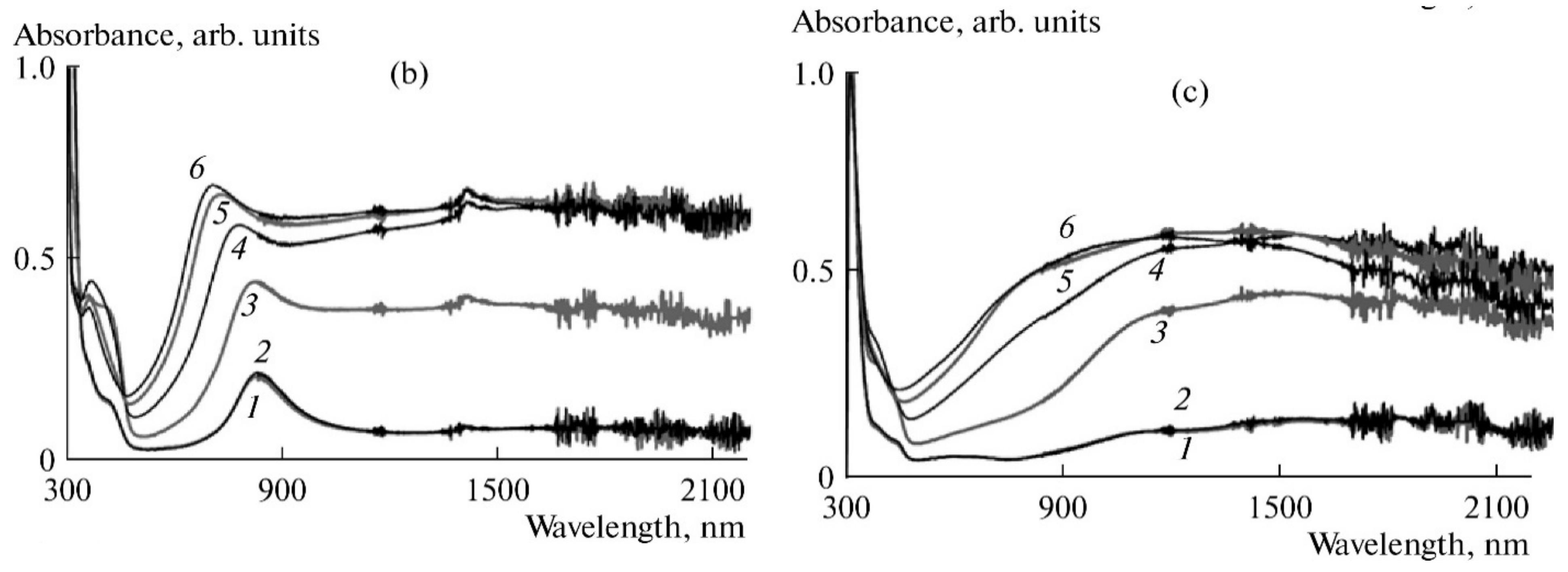


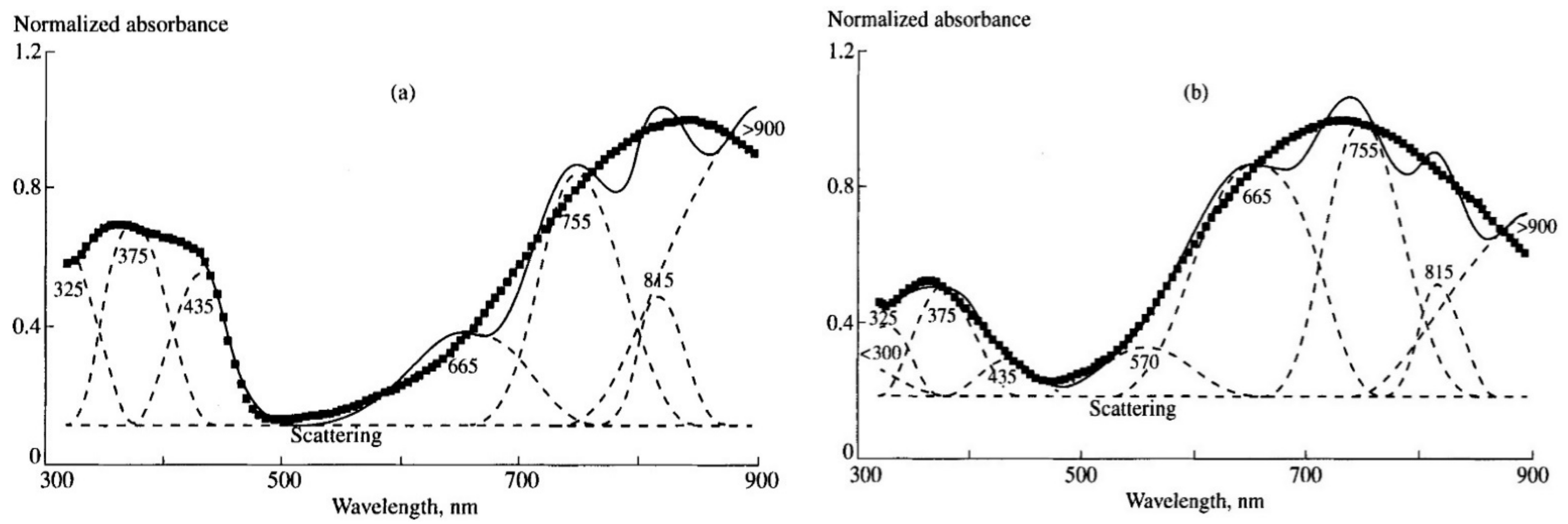
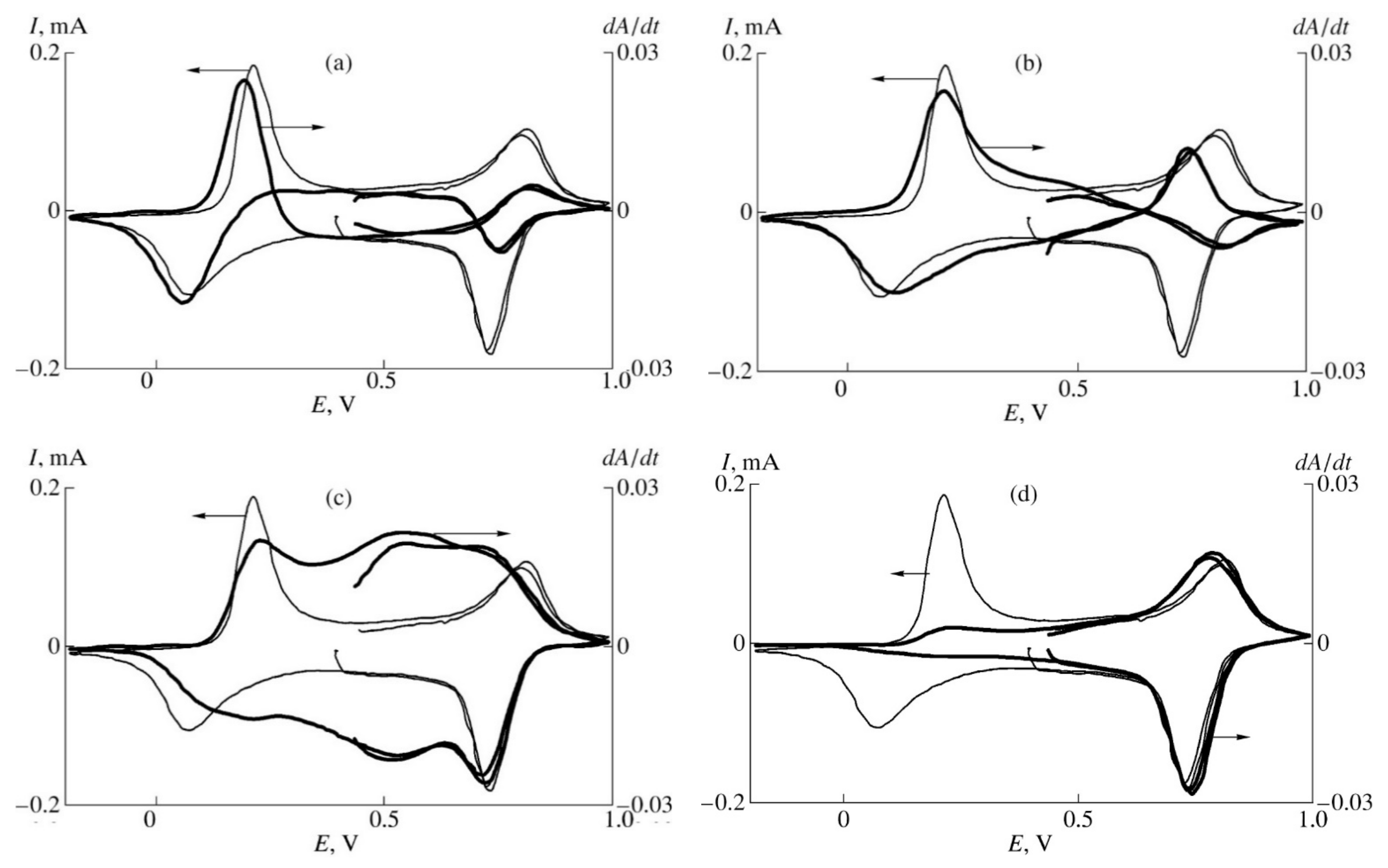

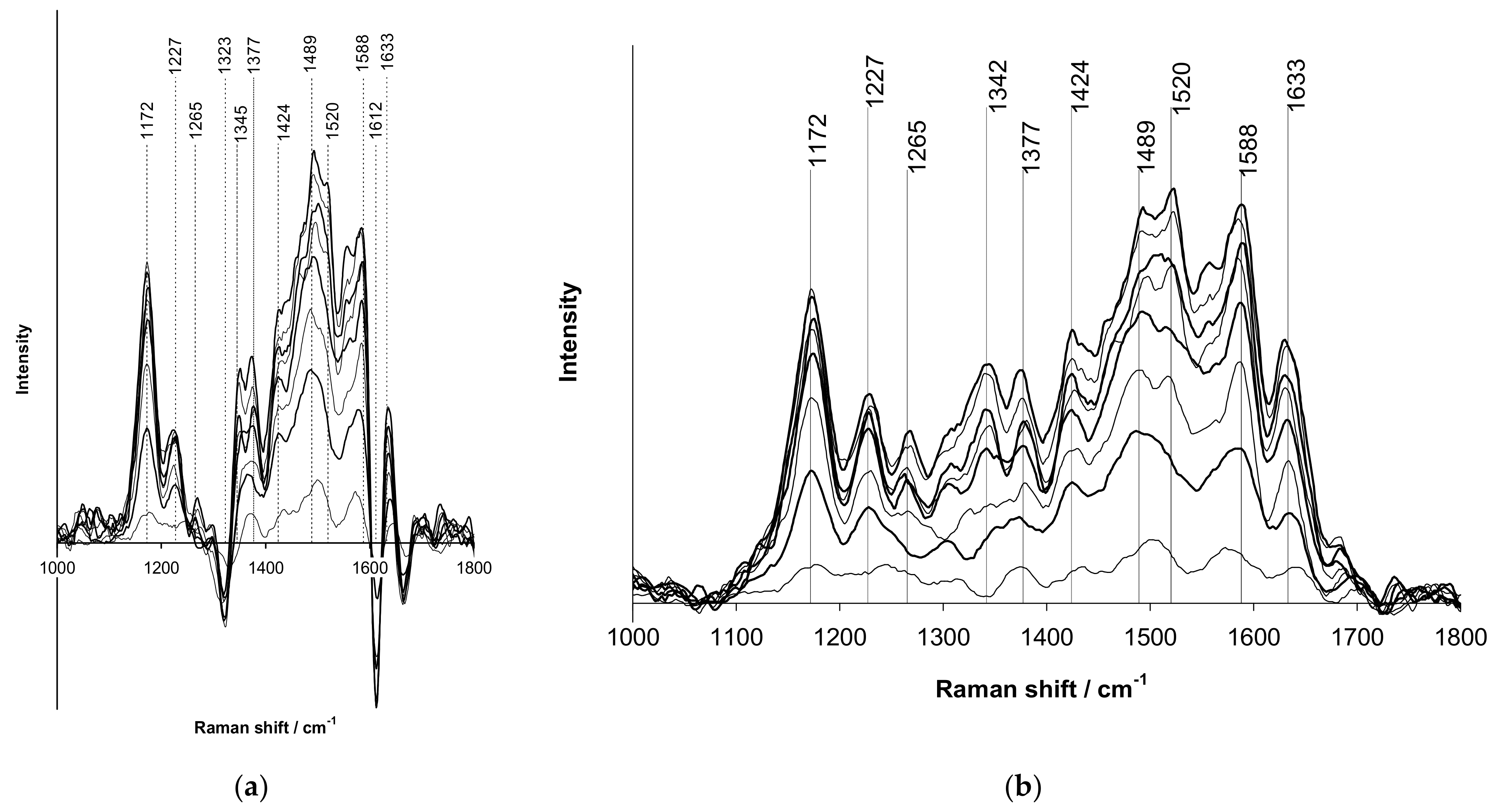

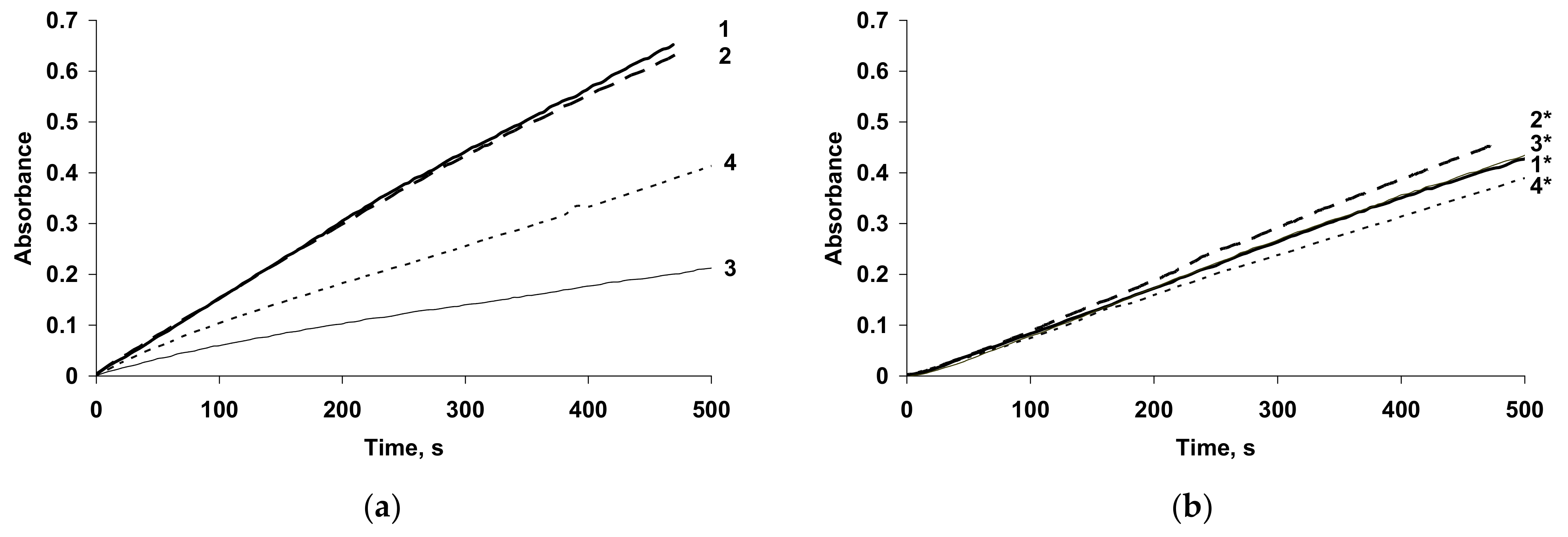
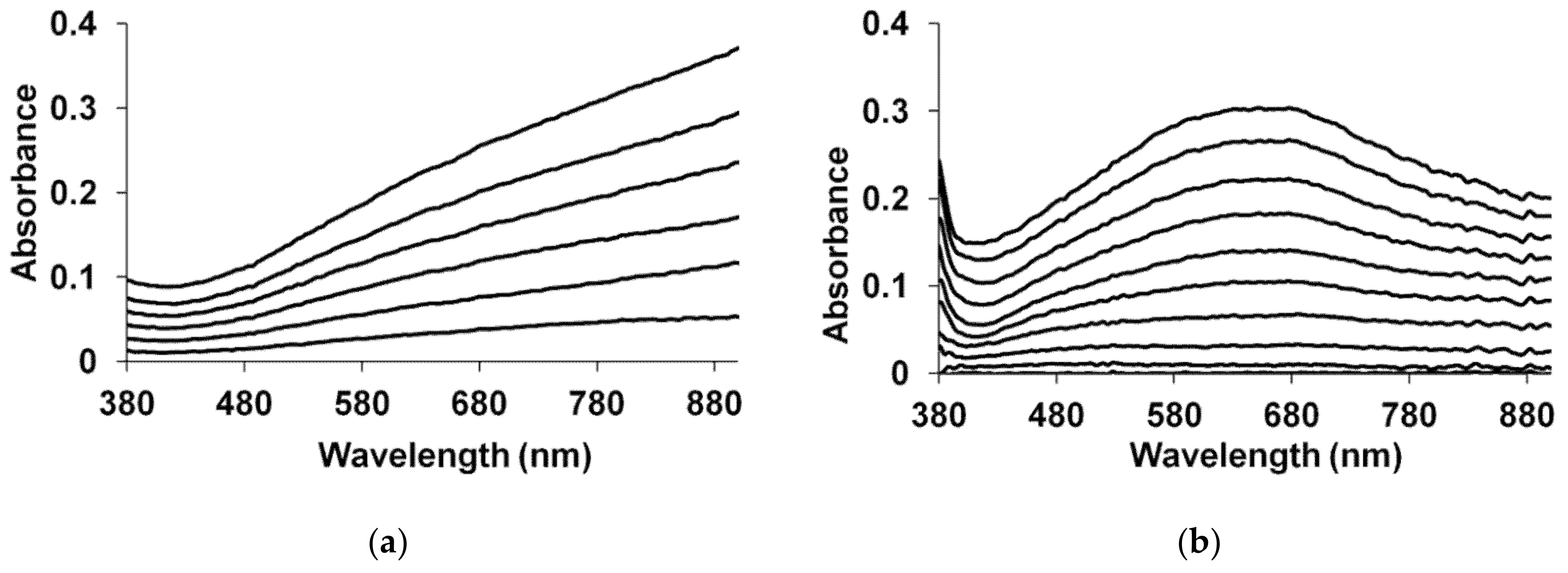


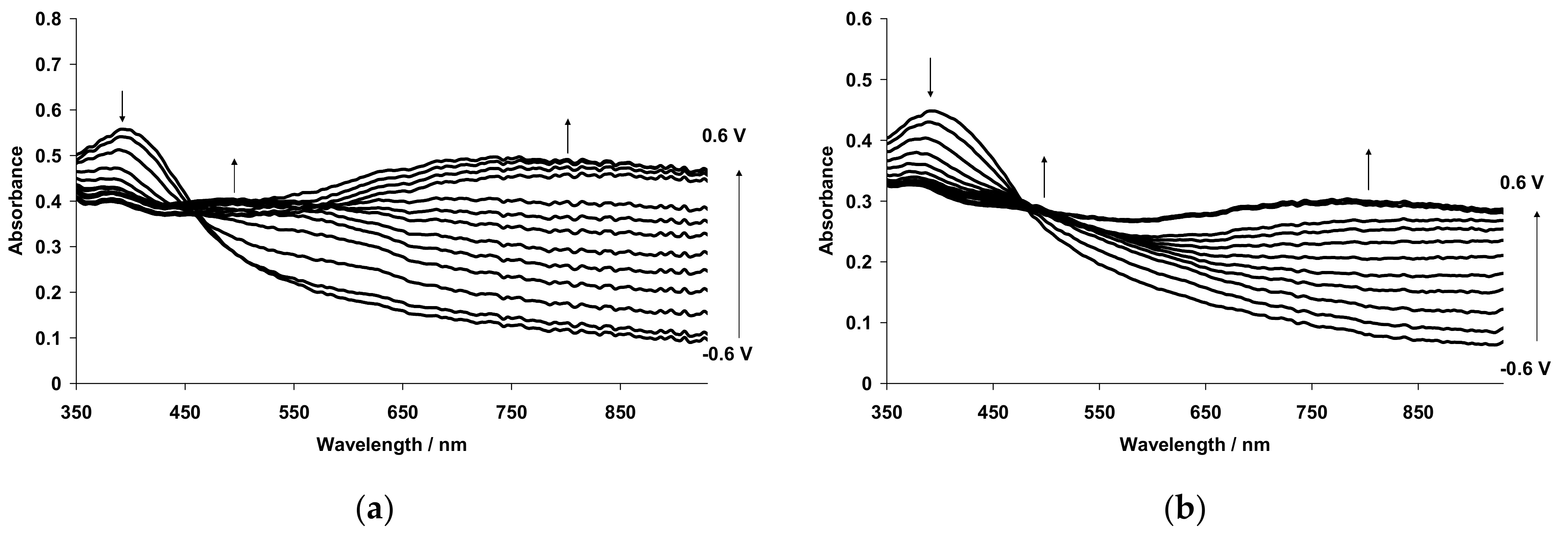

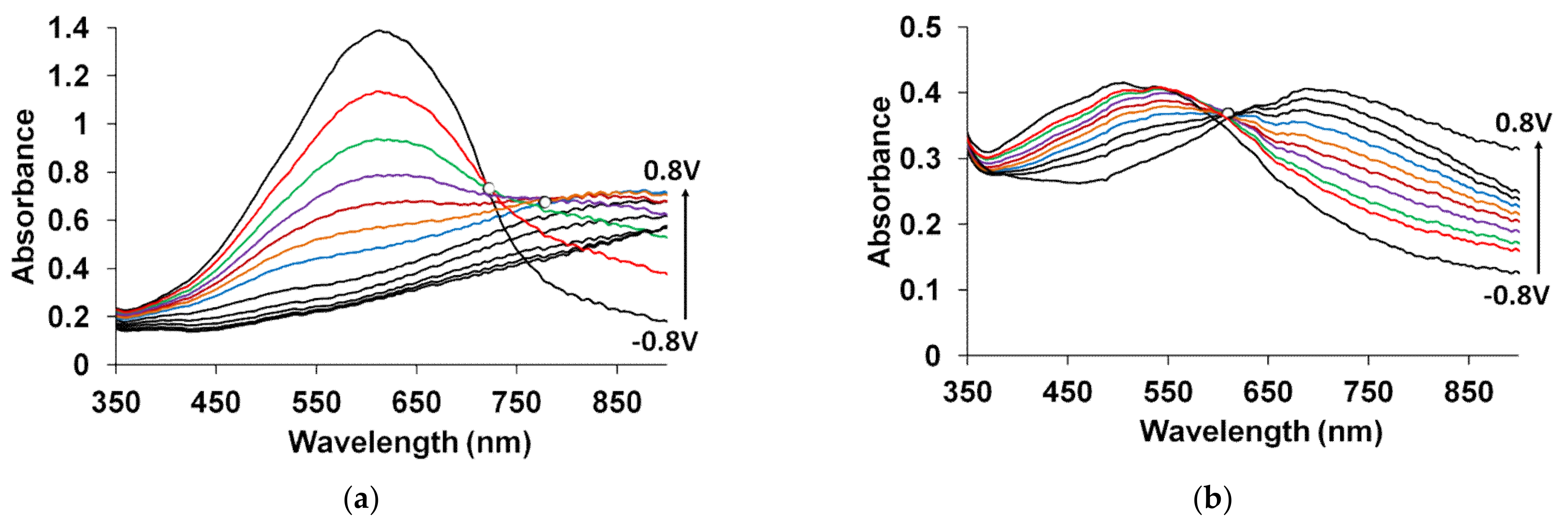

Publisher’s Note: MDPI stays neutral with regard to jurisdictional claims in published maps and institutional affiliations. |
© 2022 by the authors. Licensee MDPI, Basel, Switzerland. This article is an open access article distributed under the terms and conditions of the Creative Commons Attribution (CC BY) license (https://creativecommons.org/licenses/by/4.0/).
Share and Cite
Gribkova, O.L.; Nekrasov, A.A. Spectroelectrochemistry of Electroactive Polymer Composite Materials. Polymers 2022, 14, 3201. https://doi.org/10.3390/polym14153201
Gribkova OL, Nekrasov AA. Spectroelectrochemistry of Electroactive Polymer Composite Materials. Polymers. 2022; 14(15):3201. https://doi.org/10.3390/polym14153201
Chicago/Turabian StyleGribkova, Oxana L., and Alexander A. Nekrasov. 2022. "Spectroelectrochemistry of Electroactive Polymer Composite Materials" Polymers 14, no. 15: 3201. https://doi.org/10.3390/polym14153201
APA StyleGribkova, O. L., & Nekrasov, A. A. (2022). Spectroelectrochemistry of Electroactive Polymer Composite Materials. Polymers, 14(15), 3201. https://doi.org/10.3390/polym14153201





